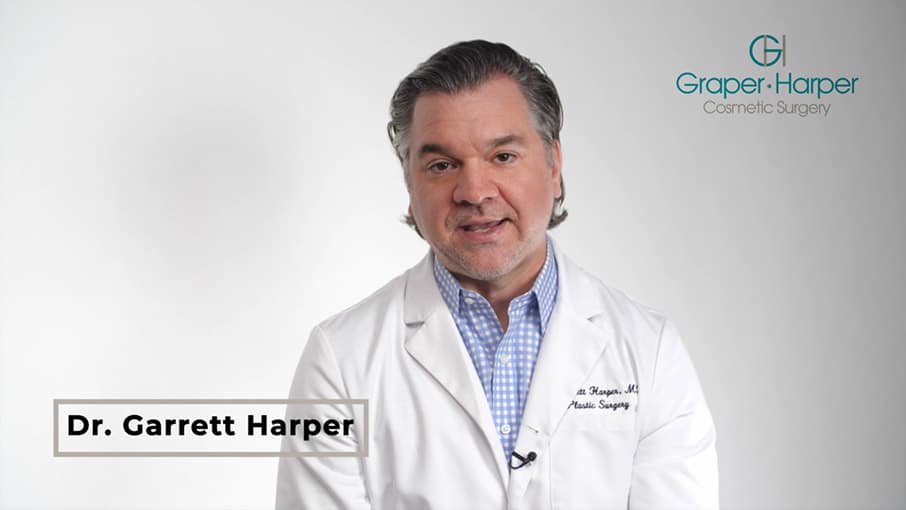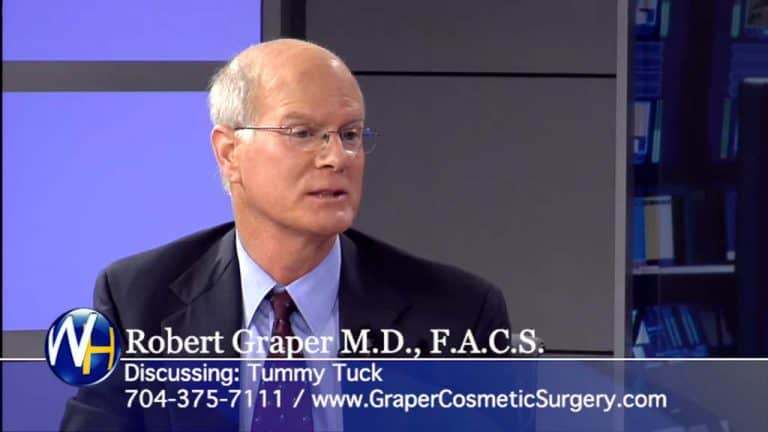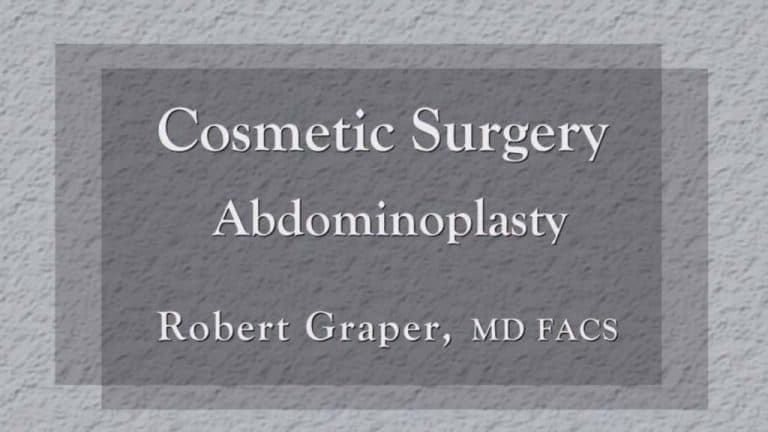Abdominoplasty with Dr. Robert Graper & Dr. Garrett Harper
Many of our tummy tuck patients desire to improve aesthetic flaws created by several pregnancies and/or weight fluctuations. Following these events, their skin becomes loose and may have stretch marks. The muscles are stretched to their limit and may even separate, causing a hernia. Many of our abdominoplasty patients are surprised to learn that repairing the weak abdominal muscles during surgery not only helps them look better, but may also greatly reduce their back pain.
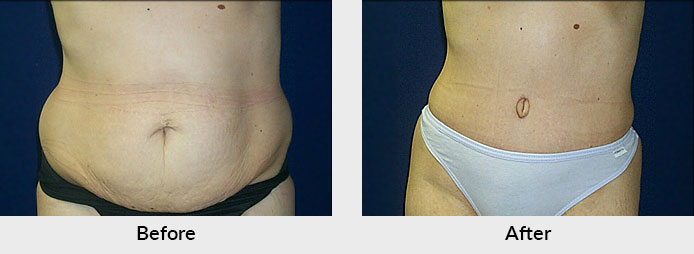
Tummy Tuck Overview
A full abdominoplasty or tummy tuck is a procedure where extra skin and fat are removed and the loose muscles are repaired. The surgery is done through an incision that is from hip to hip, but even the skimpiest bathing suit would hide it. Frequently there is enough loose skin that all of the skin between the belly button and the pubic bone can be removed. When that skin is removed, so are all the stretch marks on that skin. Extra fat is thinned from the underside to trim the abdominal contour. Then the muscles are tightened to recreate the waistline and flatten the tummy. The incision is closed with dissolvable stitches and the patient is put in a compression garment to decrease swelling and bruising.
How Tummy Tuck Is Performed
The surgery is performed at our fully accredited plastic surgery facility under general anesthesia, in which the patient is totally asleep. The surgery can be painful, as muscles are made very tight to achieve the best possible look. But these tight muscles are like having a pulled muscle in the abdomen and everyone knows that can be tender. We also require our patients to walk with their waist bent for the first seven days to lessen the tension on the skin closure. This is very important to produce healthy skin that is as tight as possible post-operatively.
We see our tummy tuck patients five to seven days after surgery in our Charlotte office. At that time the dressing is changed and the patient is allowed to shower. In seven days, the patient is allowed to stand up straight and lie flat on a bed. In order to allow the muscle and skin to adhere to each other, we recommend the abdominal area be kept quiet by limiting the bending and twisting motion of the waist for three weeks. The abdomen may seem tight at first, but will loosen with time. At three weeks, the compression garment can come off. We advise that it be worn with exercise for additional support from then on until three months. We don’t allow any isolated abdominal muscle exercise for three months, but all other exercises can be gradually increased beginning at three weeks. Most patients are back to work at approximately three weeks.
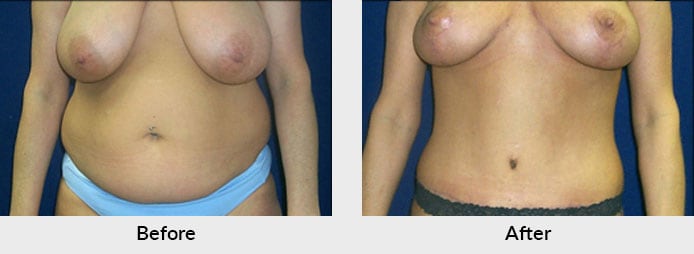
Mini Tummy Tuck Surgery
Mini abdominoplasty is a modification for the patient who only has excess skin and loose muscle from the pubic bone to the belly button. After liposuction of the entire abdomen, a C- section size incision is made and the repair done to the muscles. A smaller amount of skin is removed and the patient is put in the same compression garment as with the full procedure. Mini tummy tucks are also done in the office and do not have to walk bent at the waist at all. This procedure is great for those patients who only have a problem below the belly button. The recovery is easier than that of a full tummy tuck with a back-to-work time of 7-10 days for office-type jobs.

Potential Risks of Tummy Tuck
Like any surgery, bleeding and infection are possible risks, but occur very rarely. Incisions that don’t heal well because of decreased blood supply have occurred when the skin closure is too tight. That is why we are very cautious about keeping the waist bent for seven days after surgery. If the skin doesn’t heal well we keep it clean and moist and eventually it heals itself. This is an inconvenience we would rather avoid than treat.
Hypertrophic thick scars occur occasionally and are treated with massage, vitamin E, and compression if needed. Keloids are rare. Unresponsive scars can be surgically revised, but this is unusual.
Fluid collections under the skin can occur if the abdominal tissue is not compressed to the underlying repaired muscle. Aspiration is a sterile process where the fluid is removed by passing a needle through the skin and tapping the excess fluid. This is a painless procedure for the patient because the abdominal skin is numb for approximately 6–12 months after surgery and makes aspiration very easy. Still, we would rather prevent this fluid by wearing the compression garment than treat it with aspiration.
Tummy tuck can be combined with other procedures, such as breast lift and liposuction into a procedure known as a mommy makeover.
Our tummy tuck patients also often return to undergo minimally invasive “touch up” body sculpting procedures such as CoolSculpting. We will help you decide which procedures will help you achieve optimal results.
Abdominoplasty produces one of the most dramatic changes we see in cosmetic surgery. Patients’ lives are changed when they can return to wearing the kinds of clothes that they want to wear and participate in activities with their friends and families that they were embarrassed to do before the surgery. The surgery is not as easy on patients as liposuction, but for patients with extra skin and loose muscles, the results are far more impressive. Diet and exercise are always the first steps to improve our overall health and body shape, but no amount of diet and exercise will remove extra skin or tighten loose muscles. This is when we can make a difference by performing tummy tuck surgery.
Why Choose Dr. Graper and Dr. Harper for Your Tummy Tuck?
Our experienced cosmetic surgeons have been serving tummy tuck patients in Charlotte for many years. They are board-certified plastic surgeons and members of the American Society of Plastic Surgeons. They are highly-respected by patients and peers alike.
Frequently Asked Questions About Tummy Tuck
Hypertrophic thick scars occur occasionally and are treated with massage, vitamin E, and compression if needed. Keloid scars are rare. Unresponsive scars can be surgically revised, but this is unusual.
Fluid collections under the skin can occur if the abdominal tissue is not compressed to the underlying repaired muscle. Aspiration is a sterile process where the fluid is removed by passing a needle through the skin and tapping the excess fluid. This is a painless procedure for the patient because the abdominal skin is numb for approximately 6-12 months after surgery and makes aspiration very easy. Still, we would rather prevent this fluid by wearing the compression garment than treat it with aspiration. We will discuss in detail all the possible risks and complications during the consultation.


